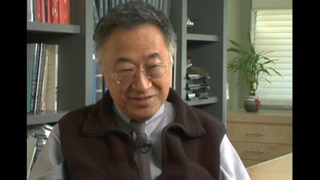Interviews
Donating clothes to the Japanese interns (Japanese)
(Japanese) Well, the war began, and the Germans, Italians, and Japanese were put into half of the internment camps. That’s where they put all of the political offenders. So I brought it [clothes] there to give, but I was asked, “Where are these clothes being donated from?” What should I say? I had to think on my feet, and I quickly replied, “From the Catholic Women’s Association. Please accept them.” Then there was a person that was in charge of the Japanese interns, so I asked, “How many Japanese are inside?” and he told me about 200. So I said, “Well this won’t be enough, but please pass them out to the people who seem to need it the most,” and with that, I left the clothes there and headed home.
Date:
Location: Brazil
Contributed by: Caminho da memória - 遥かなるみちのり. São Paulo, Brazil: Comissão de Elaboração da História dos 80 Anos de Imigração Japonesa no Brasil, 1998. VHS.
Explore More Videos

Response to loyalty questionnaire
(b.1909) Nisei from Washington. Incarcerated at Tule Lake and Minidoka during WWII. Resettled in Chicago after WWII

Move from Tule Lake to Minidoka
(b.1909) Nisei from Washington. Incarcerated at Tule Lake and Minidoka during WWII. Resettled in Chicago after WWII

Apprehension about leaving camp
(b.1909) Nisei from Washington. Incarcerated at Tule Lake and Minidoka during WWII. Resettled in Chicago after WWII

442 soldiers visiting U.S. concentration camps
(b. 1924) Political scientist, educator, and administrator from Hawai`i

Receiving a negative reaction from father upon asking about World War II experience
(b. 1939) Japanese American painter, printmaker & professor

Loss of happy-go-lucky adolescence in Puyallup Assembly Center
(b. 1923) Nisei from Washington. Resisted draft during WWII.

Memories of dusty conditions at Minidoka incarceration camp
(b. 1923) Nisei from Washington. Resisted draft during WWII.

Making the decision to resist the draft
(b. 1923) Nisei from Washington. Resisted draft during WWII.

Social activities in Tashme
(b.1920) Japanese Canadian Nisei. Established the Ikenobo Ikebana Society of Toronto

Difference between experiences of youth and older people in WWII camps
(b.1929) Pioneer medical researcher in tissue transfer and organ transplantation.

Reaction to a 1942 speech by Mike Masaoka, Japanese American Citizen League's National Secretary
(1915 - 2011) Nisei florist who resettled in New York City after WW II. Active in Japanese American civil rights movement

Death of sister in October 1942
(1915 - 2011) Nisei florist who resettled in New York City after WW II. Active in Japanese American civil rights movement

Father in camp but learning from history books
Giant Robot co-founder and publisher


Insights from family on Japanese American internment
(b. 1977) Musician, Producer, Artist
